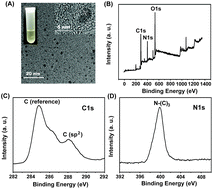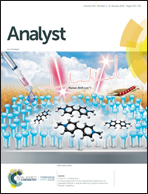Transition metal-coordinated graphitic carbon nitride dots as a sensitive and facile fluorescent probe for β-amyloid peptide detection†
Abstract
Herein, we developed a sensitive graphitic carbon nitride quantum dot (gCNQD)-based fluorescent strategy for β-amyloid peptide monomer (Aβ) determination down to the ng mL−1 level for the first time. To realize this goal, the nanostructured gCNQDs were firstly coordinated with four transition metal ions (Cu2+, Cu+, Fe3+, Zn2+). Our findings showed that the fluorescence (FL) intensity of gCNQDs was quenched in the presence of these metal ions possibly due to the effective chelation with the nitrogen element in gCNQDs and subsequent photoinduced electron transfer (PET) of gCNQDs. The degree of fluorescence quenching was found to be the most intense with the addition of Cu2+ and therefore, we selected Cu2+ as the quencher for the following Aβ determination. Through binding to Cu2+, the introduction of Aβ unexpectedly induced a further decline of FL intensity. Importantly, on account of different peptide sequences coexisting in the same cerebral system, including Aβ1–11, Aβ1–16, Aβ1–38, Aβ1–40 and Aβ1–42, their affinities to Cu2+ could be reflected by the distinguished declining extent of FL intensity. The possible mechanism of Aβ sensing by the probe was clarified by TEM characterization. The developed fluorescent biosensor was demonstrated to give a wide linear range from 1 to 700 ng mL−1 and a low detection limit of 0.18 ng mL−1 for Aβ1–42. In the end, the proposed fluorescence approach was successfully applied to monitoring of Aβ1–42 variations in the cortex and hippocampus of AD rats.

- This article is part of the themed collections: Optical Biosensor Devices and Bioanalytical Sensors


 Please wait while we load your content...
Please wait while we load your content...